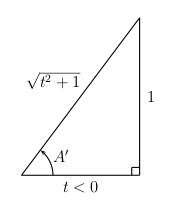Exercise 4.5.8 solution
If we correctly label the pseudo-triangle for a second quadrant angle, the task becomes simple. In the second quadrant, the adjacent side is negative and the opposite side positive, since the signs of the sides of a pseudo-triangle always take the respective signs of the \(x\) and \(y\) coordinates on the given quadrant. Since the angle is in quadrant II and we are given that \(\cot A=t\) we label the adjacent side \(t\) (which must be negative in quadrant II) and the opposite side \(1\).

- \(\sin A=\dfrac{1}{\sqrt{t^2+1}} > 0\)
- \(\cos A=\dfrac{t}{\sqrt{t^2+1}} <0 \)
- \(\tan A=\dfrac{1}{t} < 0\)
- \(\csc A=\dfrac{\sqrt{t^2+1}}{1}=\sqrt{t^2+1} > 0\)
- \(\sec A=\dfrac{t}{\sqrt{t^2+1}}= < 0\)
- \(\cot A=\dfrac{t}{1}=t < 0\)